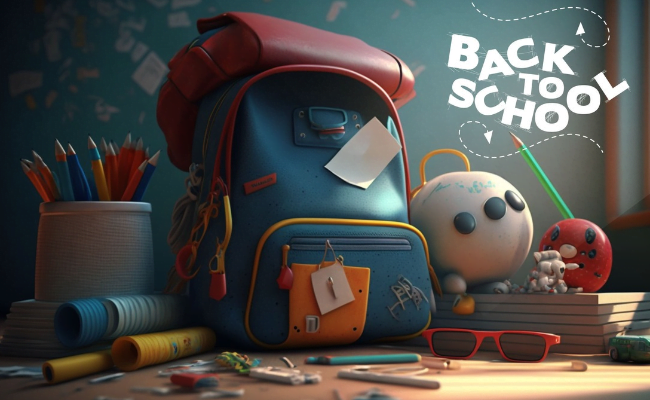It’s that time again! Yes, we’re talking about the ‘back to school’ fever. August is National Back to School Month, bridging summer and the school year. This season, families and schools face unique challenges – from adjusting to new routines to navigating the plethora of school supplies.
It’s not just about pencils and books anymore; it’s about preparing mentally, emotionally, and physically for the year ahead.
Preparing Families and Schools: Setting the Rhythm Right
Transitioning from lazy summer mornings to a strict school routine can be jarring. To ensure that the shift is seamless, it’s crucial to set the rhythm right:
1. Creating a New Routine
- Sleeping Habits: Begin by gently adjusting your child’s bedtime about two weeks before school resumes. A gradual shift will prevent the back-to-school morning chaos and ensure they’re bright-eyed for their first day.
- Meal Times: Aligning meal schedules with school timings can help regulate your child’s appetite. Start by serving breakfast a bit earlier, matching it with school starting time. And don’t forget about lunch! Try to sync your mid-day meals with the school’s lunch break.
2. Organizing the Family Schedule
With school resuming, so does the whirlwind of extracurricular activities, parent-teacher meetings, and project deadlines. Keeping track can be daunting for families and schools alike.
- Family Calendar: A family calendar can be your savior. Use color-coded markers for each family member. Place this calendar in a communal space, maybe the kitchen, ensuring it’s visible to all. This simple tool will help synchronize everyone’s schedules.
- Essential School Supplies: Most schools give a supply list for each grade. It’s good to have basic supplies at home too. Organize a stationery drawer with essentials like pens, notebooks, erasers, and rulers. This will avoid last-minute scrambles for a missing pencil or notebook.
- The Nightly Routine: Cultivate a habit of laying out the next day’s outfit and checking backpacks the night before. This small step can significantly reduce morning chaos. Also, why not set the breakfast table in advance? It’s a time-saver!
- Document Ready: Keep a folder with essential documents, like vaccination records, birth certificates, and previous report cards. Schools often require these during the first week, and having them handy can save a lot of stress.
3. The Pre-School Dry Run
If your child is going to a new school or grade, show them the route. It can help reduce first-day worries. If they’re walking, take a stroll together a few days prior. For bus riders, identify the right bus stops, and for carpoolers, a trial run could be beneficial.
4. Addressing First-Day Jitters
Starting school, no matter the grade, can be nerve-wracking. Allow your child to communicate their fears and concerns. Sharing your own school stories can provide comfort. Set a positive tone.
It helps your child look forward to school with excitement, not fear.
Back-to-School Physicals: The Health Check-Up Every Student Needs
Before the school year starts, don’t forget the back-to-school physicals. Don’t just prepare your child academically; make sure they are in top physical condition too. Here’s why this check-up matters and what to expect.
Why are Back-to-School Physicals Essential?
Think of this physical as a proactive approach, an early detection mechanism. This check-up looks at your child’s health. It makes sure they’re ready for school activities, from gym class to daily school routines. Families and schools gain peace of mind and can catch health issues early.
Which tests do they usually conduct?
- Growth and Development Assessment: This involves checking weight, height, and other developmental milestones to ensure your child is growing adequately.
- Vision and Hearing Tests: They ensure kids see the board and hear the teacher, which are vital for learning.
- Immunizations Update: The doctor will check if your child’s immunizations are up-to-date, as required by many schools.
- Fitness Level Check: This is particularly important if your child plans to participate in sports. They’ll assess cardiovascular health, muscle and bone health, and overall fitness.
- Other Routine Tests: They might check blood for health problems, cholesterol, and other health signs.
Making the Most of Your Visit
Prepare beforehand. Make a list of any concerns you may have or any changes you’ve observed in your child’s health. This could range from sleep patterns and eating habits to mood swings. Discuss any family history of diseases or health issues.
It’s also a good time to discuss any school-related anxieties your child might have, as mental health is equally crucial.
Sports Physicals: Ensuring Your Child’s Readiness for the Game
Getting ready for school? If your child wants to do sports, they need a sports physical too. Having the right gear is important, but checking if your child is fit for the game is key. Here’s your guide to understanding and navigating sports physicals.
Why are Sports Physicals Different?
A regular back-to-school check looks at overall health. A sports physical focuses on athletic needs. This check sees if your child can manage the demands of their sport, prioritizing safety and performance.
Components of a Sports Physical:
- Medical History Review: It covers family health, past illnesses, surgeries, or sports injuries.
- Physical Examination: This encompasses:
- Vital Signs Check: They measure blood pressure, heart rate, and respiration rate.
- Vision Test: Important for sports that require keen eyesight.
- Musculoskeletal Exam: Assessing joints, bones, and muscles to understand flexibility, strength, and any potential areas of concern.
- Cardiovascular Examination: Listening to the heart’s rhythm and checking for any abnormalities.
- Fitness Assessment: Evaluating endurance, strength, flexibility, and other fitness parameters crucial for the specific sport your child plans to participate in.
- Discussion on Nutrition and Training: Doctors also highlight good food, hydration, and safe training for sports success.
Post-Physical Recommendations
After the exam, the doctor clears the student for sports, maybe with conditions like using protective gear, or they suggest more checks or treatments. It’s crucial to follow any suggestions or guidelines laid out to ensure the safety of your young athlete.
In Conclusion
The National Back to School Month in August is more than just about shopping for school supplies. It’s about preparing children and families mentally and emotionally for the academic year ahead. With these tips, both families and schools can ensure they’re not just prepared but eager to embrace the school year. So, as the summer sunsets, let’s welcome the scholarly season with open arms and organized plans!
Ready to Gear Up for the School Year?
Your child’s health and readiness are paramount as they dive into a new school year and their favorite sports. Don’t leave their preparation to chance. At Powers Pediatrics, we prioritize your child’s well-being and understand the urgency of last-minute checks. That’s why we offer same-day appointments to ensure your little champ is game-ready in no time!
Plus, with our acceptance of Medicaid and other major insurance providers, quality care is accessible and stress-free. Secure their spot on the field and in the classroom with confidence. Schedule your appointment with Powers Pediatrics today!



